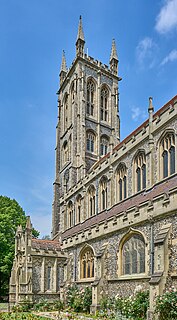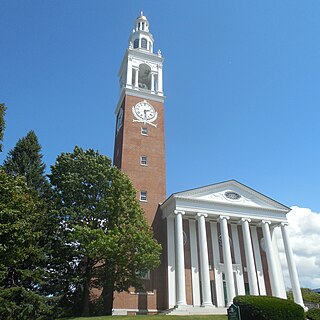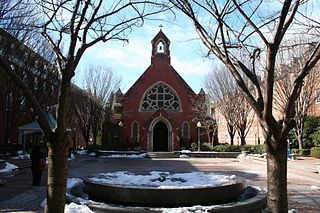
The Cathedral and Metropolitical Church of Saint Peter in York, commonly known as York Minster, is the cathedral of York, North Yorkshire, England, and is one of the largest of its kind in Northern Europe. The minster is the seat of the Archbishop of York, the third-highest office of the Church of England, and is the mother church for the Diocese of York and the Province of York. It is run by a dean and chapter, under the Dean of York. The title "minster" is attributed to churches established in the Anglo-Saxon period as missionary teaching churches, and serves now as an honorific title; the word Metropolitical in the formal name refers to the Archbishop of York's role as the Metropolitan bishop of the Province of York. Services in the minster are sometimes regarded as on the High Church or Anglo-Catholic end of the Anglican continuum.

St Mary Redcliffe is an Anglican parish church located in the Redcliffe district of Bristol, England. The church is a short walk from Bristol Temple Meads station. The church building was constructed from the 12th to the 15th centuries, and it has been a place of Christian worship for over 900 years. The church is renowned for the beauty of its Gothic architecture and is classed as a Grade I listed building by Historic England. It was famously described by Queen Elizabeth I as "the fairest, goodliest, and most famous parish church in England."

The Cathedral Church of St Peter and St Wilfrid, commonly known as Ripon Cathedral, and until 1836 known as Ripon Minster, is a cathedral in Ripon, North Yorkshire, England. Founded as a monastery by Scottish monks in the 660s, it was refounded as a Benedictine monastery by St Wilfrid in 672. The church became collegiate in the tenth century, and acted as a mother church within the large Diocese of York for the remainder of the Middle Ages. The present church is the fourth, and was built between the 13th and 16th centuries. In 1836 the church became the cathedral for the Diocese of Ripon. In 2014 the Diocese was incorporated into the new Diocese of Leeds, and the church became one of three co-equal cathedrals of the Bishop of Leeds.

The Cathedral Church of the Holy Spirit, Guildford, commonly known as Guildford Cathedral, is the Anglican cathedral at Guildford, Surrey, England. Richard Onslow donated the first 6 acres of land on which the cathedral stands, with Viscount Bennett, a former Prime Minister of Canada, purchasing the remaining land and donating it to the cathedral in 1947. Designed by Edward Maufe and built between 1936 and 1961, it is the seat of the Bishop of Guildford.

St John the Baptist Church is an Australian Anglican church in the Canberra suburb of Reid in the Australian Capital Territory. The church is located at the corner of Anzac Parade and Constitution Avenue, adjacent to the Parliamentary Triangle, and is the oldest surviving public building within Canberra's inner city and the oldest church in the Australian Capital Territory. It has been described as a "sanctuary in the city", remaining a small English village-style church even as Australia's capital grew around it. Over time, it became a focal point for Australia's governors-general, politicians, public servants and military leaders, and has hosted royalty on numerous occasions.

The Basilica of the Sacred Heart in Notre Dame, Indiana, is a Catholic church on the campus of the University of Notre Dame, also serving as the mother church of the Congregation of Holy Cross (C.S.C.) in the United States. The neo-gothic church has 44 large stained glass windows and murals completed over a 17-year period by the Vatican painter Luigi Gregori. The basilica bell tower is 230 feet (70 m) high, making it the tallest University chapel in America. It is a contributing building in Notre Dame's historic district listed on the National Register of Historic Places. The Basilica is a major tourist attraction in Northern Indiana, and is visited annually by more than 100,000 tourists.

Heinz Memorial Chapel is a Pittsburgh History and Landmarks Foundation Historic Landmark and a contributing property to the Schenley Farms National Historic District on the campus of the University of Pittsburgh in Pittsburgh, Pennsylvania, United States.

The Cathedral Church of Saint Matthew, known simply as St. Matthew's Cathedral, is an Episcopal cathedral church located at 5100 Ross Avenue in Dallas, Texas, in the United States.

The Chapel of the Resurrection is the centerpiece structure on the campus of Valparaiso University in Valparaiso, Indiana.

St. Paul's Chapel is a chapel building of Trinity Church, an episcopal parish, located at 209 Broadway, between Fulton Street and Vesey Street, in Lower Manhattan, New York City. Built in 1766, it is the oldest surviving church building in Manhattan, and one of the nation's finest examples of Late Georgian church architecture.

Duke University Chapel is a chapel located at the center of the campus of Duke University in Durham, North Carolina, United States. It is an ecumenical Christian chapel and the center of religion at Duke, and has connections to the United Methodist Church. Constructed from 1930 to 1932, the Chapel seats about 1,800 people and stands 210 feet tall, making it one of the tallest buildings in Durham County. It is built in the Collegiate Gothic style, characterized by its large stones, pointed arches, and ribbed vaults. It has a 50-bell carillon and three pipe organs, one with 5,033 pipes and another with 6,900 pipes.

St. Paul's Episcopal Church in Troy, New York, United States, is located at Third and State streets. It is home to one of the oldest congregations in the city. In 1979, the church and two outbuildings were added to the National Register of Historic Places. Seven years later, when the Central Troy Historic District was created and added to the Register, it was listed as a contributing property.

Crouse College, also known as Crouse Memorial College and historically as John Crouse Memorial College for Women, is a building on the Syracuse University campus. It was funded by John R. Crouse, a wealthy Syracuse merchant with the White family, and designed by Archimedes Russell. It is built in the Romanesque revival—Richardsonian Romanesque style.

The United States Air Force Academy Cadet Chapel, completed in 1962, is the distinguishing feature of the Cadet Area at the United States Air Force Academy north of Colorado Springs. It was designed by Walter Netsch of Skidmore, Owings and Merrill of Chicago. Construction was accomplished by Robert E. McKee, Inc., of Santa Fe, New Mexico. Originally controversial in its design, the Cadet Chapel has become a classic and highly regarded example of modernist architecture. The Cadet Chapel was awarded the American Institute of Architects' National Twenty-five Year Award in 1996 and, as part of the Cadet Area, was named a U.S. National Historic Landmark in 2004.

St Mary's Church is the main Church of England parish church for the areas of Portsea and Fratton, both located in the city of Portsmouth, Hampshire. Standing on the oldest church site on Portsea Island, the present building, amongst the largest parish churches in the country, has been described as the "finest Victorian building in Hampshire". It is at least the third church on the site and has been designated a Grade II* listed building by Historic England. Former regular worshippers here have included Charles Dickens, Isambard Kingdom Brunel, and Cosmo Lang.

The Sophia Astley Kirkpatrick Memorial Chapel, known as Kirkpatrick Chapel, is the chapel to Rutgers, The State University of New Jersey and located on the university's main campus in New Brunswick, New Jersey in the United States. Kirkpatrick Chapel is among the university's oldest extant buildings, and one of six buildings located on a historic section of the university's College Avenue Campus in New Brunswick known as the Queens Campus. Built in 1872 when Rutgers was a small, private liberal arts college, the chapel was designed by architect Henry Janeway Hardenbergh at the beginning of his career. Hardenbergh, a native of New Brunswick, was the great-great-grandson of Rutgers' first president, the Rev. Jacob Rutsen Hardenbergh. It was the third of three projects that Hardenbergh designed for the college.

Ira Allen Chapel is a building on the campus of the University of Vermont (UVM), which is located on the northeast corner of the "University Green" in Burlington, Vermont. The building was constructed during 1925–26, and dedicated on January 14, 1927. It was added to National Register of Historic Places as part of University Green Historic District on April 14, 1975.

Dahlgren Chapel of the Sacred Heart, often shortened to Dahlgren Chapel, is a Roman Catholic chapel located in Dahlgren Quadrangle on the main campus of Georgetown University in Washington, D.C. Built in 1893, it is located in the historic center of the campus.

Somerville College Chapel is the chapel of Somerville College, Oxford. The chapel is unique among Oxford colleges because it has no religious affiliation - reflecting the non-sectarian foundation of the college as place for the higher education of women. It can be seen as both a manifestation of the aspirations of liberal Christianity in the interwar years, including the advancement of women and ecumenism, and of the contestation of the role of religion in higher education among elites in the same period.

Vale Royal Methodist Church, also historically Vale Royal Chapel and Vale Royal Wesleyan Methodist Church, was a Methodist Church of Great Britain parish church in Royal Tunbridge Wells, Kent, England. It was opened in 1873 and stopped being used as a church on Easter 2015. It was later renovated to become a gym.




















